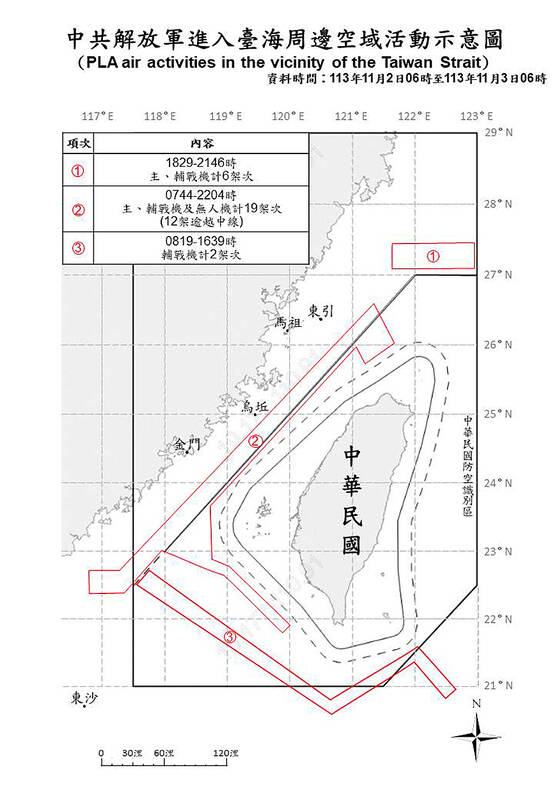The Ministry of National Defense (MND) yesterday said it spotted 35 Chinese military aircraft, including fighters and bombers, flying to the south of Taiwan proper on the way to exercises in the Pacific, a second consecutive day it has reported such activities.
The Chinese Ministry of National Defense did not respond to a request for comment on the missions, reported just days before tomorrow’s US presidential election.
The US is bound by law to provide Taiwan with the means to defend itself. Its arms sales to Taipei include a US$2 billion missile system announced last month.

Photo courtesy of the Ministry of National Defense
The MND said that from 9am yesterday, it had detected 37 Chinese military aircraft, including J-16 fighters, nuclear-capable H-6 bombers and drones.
Of those, 35 flew to Taiwan’s southwest, south and southeast into the western Pacific to carry out long-range training, the ministry said, adding that it had dispatched its own forces to keep watch.
On Saturday, the ministry said China had carried out another “joint combat readiness patrol” with warships and aircraft near Taiwan.
In related news, a source yesterday said that the first sets of M142 High Mobility Artillery Rocket Systems (HIMARS) purchased from the US in 2020 and 2022 arrived in Taiwan last month ahead of schedule.
The military purchased 29 sets of HIMARS in two procurements, with the first 11 sets originally scheduled to arrive between the end of this year and the beginning of next year, and the remainder in 2026.
The 58th Artillery Command of the 10th Army Corps stationed in central Taiwan is training with the platforms, the source said.
Taiwan had originally sought to purchase M109A6 howitzer artillery weapons from the US, but later worked out a deal to purchase HIMARS after the howitzers became unavailable.
Along with the HIMARS, the procurement included 84 MGM-140 Army Tactical Missile Systems (ATACMS), 864 precision rockets, two sets of training simulators and other ancillary equipment.
The HIMARS are to be operated by the army, while the air force’s Air Defense and Missile Command would continue to operate domestically produced Hsiung Feng (“Brave Wind,” 雄風) missile systems. The ATACMS would be deployed based on assessments by the General Staff Headquarters units.
During an interview Su Tzu-yun (蘇紫雲), a research fellow at the state-run Institute for National Defense and Security Research, said that Taiwan would use two types of munitions with the HIMARS: a traditional rocket with a range of 50km to 70km and ATACMS missiles with a range of 300km.
The military could possibly acquire Precision Strike Missiles with a range of nearly 500km, he said.
The sale of the 300km-range missiles to Taiwan signaled mutual trust between Taipei and Washington, which would facilitate future procurements, he said.

TRAGEDY STRIKES TAIPEI: The suspect died after falling off a building after he threw smoke grenades into Taipei Main Station and went on a killing spree in Zhongshan A 27-year-old suspect allegedly threw smoke grenades in Taipei Main Station and then proceeded to Zhongshan MRT Station in a random killing spree that resulted in the death of the suspect and two other civilians, and seven injured, including one in critical condition, as of press time last night. The suspect, identified as a man surnamed Chang Wen (張文), allegedly began the attack at Taipei Main Station, the Taipei Fire Department said, adding that it received a report at 5:24pm that smoke grenades had been thrown in the station. One man in his 50s was rushed to hospital after a cardiac arrest

SAFETY FIRST: Double the number of police were deployed at the Taipei Marathon, while other cities released plans to bolster public event safety Authorities across Taiwan have stepped up security measures ahead of Christmas and New Year events, following a knife and smoke bomb attack in Taipei on Friday that left four people dead and 11 injured. In a bid to prevent potential copycat incidents, police deployments have been expanded for large gatherings, transport hubs, and other crowded public spaces, according to official statements from police and city authorities. Taipei Mayor Chiang Wan-an (蔣萬安) said the city has “comprehensively raised security readiness” in crowded areas, increased police deployments with armed officers, and intensified patrols during weekends and nighttime hours. For large-scale events, security checkpoints and explosives

PUBLIC SAFETY: The premier said that security would be tightened in transport hubs, while President Lai commended the public for their bravery The government is to deploy more police, including rapid response units, in crowded public areas to ensure a swift response to any threats, President William Lai (賴清德) said yesterday after a knife attack killed three people and injured 11 in Taipei the previous day. Lai made the remarks following a briefing by the National Police Agency on the progress of the investigation, saying that the attack underscored the importance of cooperation in public security between the central and local governments. The attack unfolded in the early evening on Friday around Taipei Main Station’s M7 exit and later near the Taipei MRT’s Zhongshan

A car bomb killed a senior Russian general in southern Moscow yesterday morning, the latest high-profile army figure to be blown up in a blast that came just hours after Russian and Ukrainian delegates held separate talks in Miami on a plan to end the war. Kyiv has not commented on the incident, but Russian investigators said they were probing whether the blast was “linked” to “Ukrainian special forces.” The attack was similar to other assassinations of generals and pro-war figures that have either been claimed, or are widely believed to have been orchestrated, by Ukraine. Russian Lieutenant General Fanil Sarvarov, 56, head